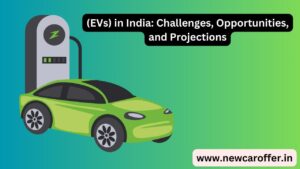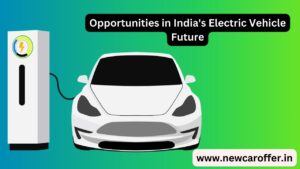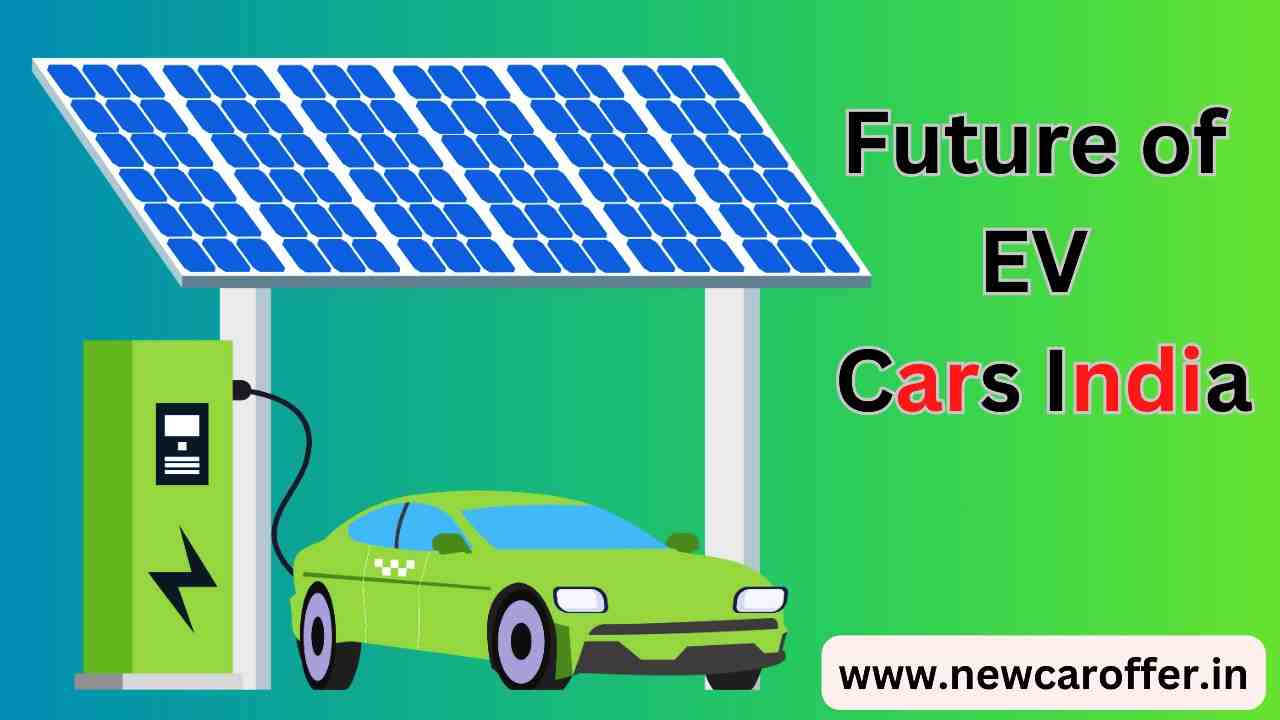The Future of EV Cars Electric Vehicles (EVs) in India: Challenges, Opportunities, and Projections.

India, the world’s third-largest greenhouse gas emitter, is preparing for a significant change in its automotive landscape. which is very good news for our country, India.
The Indian government’s ambitious push for electric vehicles (EVs) marks a significant shift towards sustainable transportation. This article highlights the future of EVs in India, exploring the challenges, opportunities and projections that will shape the industry.
Government Initiatives and Policies
The Indian government has been proactively driving the adoption of electric vehicles (EVs) through various initiatives and policies. These efforts aim to reduce the country’s dependence on fossil fuels, mitigate environmental impact, and create a sustainable transportation ecosystem and future of EV Cars.
Key Government Initiatives
1. FAME (Faster Adoption and Manufacturing of Electric Vehicles) Scheme: Launched in 2015, FAME provides subsidies to EV manufacturers and customers, incentivizing the production and purchase of Future of EV Cars.
2. National Electric Mobility Mission Plan (NEMMP): This plan aims to achieve 30% electrification of India’s vehicle fleet by 2030.
3. Electric Vehicle Policy: The government has drafted a comprehensive policy to promote EV adoption, including tax exemptions, reduced GST rates, and investment incentives.
Policies and Incentives
1. GST Reduction: EVs are taxed at a lower rate (5%) compared to traditional vehicles (28-50%).
2. Customs Duty Exemption: Import duty exemptions for EV parts and components.
3. Income Tax Benefits: Tax deductions for EV buyers and manufacturers.
4. Subsidies for Charging Infrastructure: Government support for setting up charging stations.
State-Level Initiatives
1. Delhi Electric Vehicle Policy: Aims to register 25% EVs by 2024.
2. Kerala Electric Vehicle Policy: Targets 1 million EVs by 2025.
3. Tamil Nadu Electric Vehicle Policy: aims for 1.5 million EVs by 2030.
Impact and Projections
Sale Projections: 30-40% of new car sales are expected to be EVs by 2030.
Charging Infrastructure Growth: 10,000 charging stations expected by 2025.
Job Creation: estimated 10 lakh jobs in the EV sector by 2030.
Challenges and future directions
Infrastructure Development: Expanding charging infrastructure.
Technology Advancements: Improving battery efficiency and reducing costs.
Public Awareness: Educating consumers about EV benefits.
Conclusion
The Indian government’s initiatives and policies have created a conducive environment for EV adoption. As the country moves towards a sustainable transportation future, these efforts will play a crucial role in driving growth, innovation, and environmental sustainability.
Challenges Facing India’s Electric Vehicle
As India embarks on an ambitious journey to electrify its transportation sector, several challenges must be addressed to ensure a smooth transition. This article delves into the key hurdles facing the adoption of electric vehicles Future of EV Cars. top best selling car
Infrastructure Challenges
1. Charging Infrastructure: Limited charging stations (currently 1,500) hinder widespread adoption.
2. Power Grid Capacity: Upgrading the power grid to support increased electricity demand.
3. Standardization: Lack of standardization in charging ports and protocols.
Technological Challenges
1. Battery Technology: High costs, limited range and battery durability concerns.
2. Charging Time: Long charging times (4-6 hours) hinder convenience.
3. Heat Management: Controlling battery-generated heat in tropical regions.
Economic Challenges
1. High Upfront Costs: EVs are currently more expensive than traditional vehicles.
2. Battery Cost: High battery costs (50-60% of EV cost) affect affordability.
3. Depreciation: Rapid depreciation of EVs affects resale value.
Regulatory Challenges
1. Lack of Clear Policies: Uncertainty around long-term policies and incentives.
2. Tariff and Taxation: Unfavorable tariff and taxation policies for EV imports.
3. Safety and Security: Concerns around EV safety and security standards.
Social Challenges
1. Public Awareness: Limited awareness about EV benefits and advantages.
2. Range Anxiety: Fear of running out of charge affects adoption.
3. Job disruption: potential job losses in the traditional automotive sector.
Innovative Solutions
1. Battery Swapping: Companies like Ola Electric and Sun Mobility offer battery swapping services.
2. Charging Infrastructure Expansion: Government and private initiatives are expanding charging networks.
3. Range Extension: Advances in battery technology and vehicle design.
Government Support
1. FAME Scheme: Government subsidies for EV manufacturers and customers.
2. Investment Incentives: Tax breaks and investment incentives for EV manufacturers.
3. Research and Development: Government funding for EV research and development.
Conclusion
Addressing these challenges will be crucial to India’s electric vehicle revolution. With government support, innovative solutions and increasing public awareness, India can overcome the hurdles and achieve its ambitious EV adoption targets, Future of EV Cars.
Opportunities in India’s Electric Vehicle Future

The market for electric vehicles (EVs) in India is expected to grow rapidly due to government assistance, advances in technology, and rising demand for environmentally friendly transportation. This article explores the opportunities that will shape the future of EVs in India.
Market Opportunities
1. Growing Demand: Projected 30-40% of new car sales to be EVs by 2030.
2. Increasing Investment: Attracting investments in EV manufacturing, battery technology and charging infrastructure.
3. Job Creation: Estimated 10 lakh jobs in the EV sector by 2030.
Technological Opportunities
1. Battery Advancements: Improvements in battery efficiency, range and affordability.
2. Charging Infrastructure Expansion: Government and private initiatives to establish 10,000 charging stations by 2025.
3. Vehicle-to-Grid (V2G) Technology: Enabling EVs to supply electricity back to the grid.
Economic Opportunities
1. Reduced Import Dependence: Localizing EV manufacturing to reduce reliance on imports.
2. Cost Savings: Lower operating costs and reduced maintenance expenses.
3. New Business Models: Subscription-based services, battery swapping and charging infrastructure.
Environmental Opportunities
1. Reduced Emissions: Decreasing greenhouse gas emissions and air pollution.
2. Sustainable Transportation: Promoting eco-friendly transportation options.
3. Waste Management: Recycling and repurposing EV batteries.
Government Support
1. FAME Scheme: Government subsidies for EV manufacturers and customers.
2. Investment Incentives: Tax breaks and investment incentives for EV manufacturers.
3. Research and Development: Government funding for EV research and development.
Key Players
1. Tata Motors: Leading the charge with its Nexon EV and Tigor EV.
2. Mahindra & Mahindra: Offering a range of EVs, including the e-Verito and e-KUV100.
3. Ola Electric: Revolutionizing the two-wheeler market with its affordable EVs.
Innovative Solutions
1. Battery Swapping: Companies like Ola Electric and Sun Mobility offer battery swapping services.
2. Charging Infrastructure Expansion: Government and private initiatives to establish charging networks.
3. Range Extension: Advances in battery technology and vehicle design.
Conclusion
India’s EV market presents numerous opportunities for growth, innovation and sustainability. With government support, technological advancements and increasing demand, Future of EV Cars in India looks bright.
Projections for the EV Market

As India gears up for a sustainable transportation revolution, electric vehicles (EVs) are poised to play a pivotal role. This article provides insights into the projected growth of the EV market in India, driven by government support, technological advancements and increasing demand.
Sales Projections
1. 30-40% Market Share: EVs expected to account for 30-40% of new car sales by 2030.
2. 10 Million EVs on Road: Projected 10 million EVs on Indian roads by 2030.
3. Annual Sales Growth: 20-25% annual growth rate for EV sales.
Charging Infrastructure Projections
1. 10,000 Charging Stations: Government target of establishing 10,000 charging stations by 2025.
2. Fast-Charging Corridors: Development of fast-charging corridors along highways.
3. Urban Charging Infrastructure: Expansion of charging infrastructure in cities.
Battery Technology Projections
1. Advanced Battery Chemistry: Adoption of advanced battery chemicals like lithium-ion and solid-state batteries.
2. Battery Cost Reduction: projected 50% reduction in battery costs by 2025.
3. Local Battery Manufacturing: Increased local battery manufacturing to reduce import dependence.
Government Support Projections
1. FAME Scheme Expansion: Government subsidies for EV manufacturers and customers to increase.
2. Investment Incentives: Tax breaks and investment incentives for EV manufacturers to continue.
3. Research and Development Funding: increased government funding for EV research and development.
Key Player Projections
1. Tata Motors is expected to maintain market leadership with its Nexon EV and Tigor EV.
2. Mahindra & Mahindra: projected to expand its EV portfolio with new launches.
3. Ola Electric is expected to disrupt the two-wheeler market with its affordable EVs.
Regional Projections
1. Delhi-NCR: expected to emerge as a hub for EV adoption.
2. Mumbai-Pune: projected to witness significant EV growth.
3. Bengaluru: expected to become a key market for EVs.
Conclusion
Thanks to rising demand, government support, and technology developments, India’s EV market is expected to grow rapidly. These forecasts demonstrate the potential and opportunities for the Indian EV market.
Transforming India’s EV Landscape
India’s electric vehicle (EV) ,market is on the cusp of a revolution, driven by innovative solutions that address the challenges of adoption, affordability and sustainability. This article explores the cutting-edge technologies and business models that will shape the future of EVs in India.
Battery Innovations
1. Solid-State Batteries: Replacing liquid electrolytes with solid materials for enhanced safety and efficiency.
2. Lithium-Air Batteries: Leveraging oxygen to increase energy density and reduce costs.
3. Battery Swapping: Interchangeable batteries for convenient, rapid recharging.
Charging Infrastructure Solutions
1. Fast-Charging Corridors: High-speed charging along highways for seamless long-distance travel.
2. Urban Charging Hubs: Convenient, accessible charging points in cities.
3. Solar-Powered Charging: Renewable energy integration for sustainable charging.
Vehicle-to-Grid (V2G) Technology
1. Bi-Directional Charging: EVs supplying electricity back to the grid.
2. Grid Stabilization: EVs help stabilize the grid during peak demand.
3. Vehicle-to-Home (V2H): EVs powering homes and businesses.
Smart Mobility Solutions
1. Electric Vehicle Sharing: Subscription-based services for affordable, convenient mobility.
2. Mobility-as-a-Service (MaaS): Integrated public, private and shared transportation.
3. Autonomous Vehicles: Self-driving EVs for enhanced safety and efficiency.
Sustainable Manufacturing
1. Local Supply Chain Development: Reducing reliance on imports.
2. Recycling and Repurposing: Closed-loop production and waste management.
3. Eco-Friendly Materials: Sustainable materials for vehicle construction.
Government Initiatives
1. FAME Scheme: Government subsidies for EV manufacturers and customers.
2. Investment Incentives: Tax breaks and investment incentives for EV manufacturers.
3. Research and Development Funding: Government support for EV innovation.
Key Players
1. Tata Motors: Pioneering EV adoption with Nexon EV and Tigor EV.
2. Mahindra & Mahindra: Expanding EV portfolio with new launches.
3. Ola Electric: Disrupting the two-wheeler market with affordable EVs.
Conclusion
India has a promising future for EVs thanks to creative solutions that tackle affordability, sustainability, and adoption. These cutting-edge technologies and business models will transform the EV market and enable a cleaner, more connected, and more convenient transportation ecosystem.
Overcoming the Challenges in India’s EV Market
The future of electric vehicles (EVs) in India is bright, but safety concerns remain a significant challenge. As the country accelerates its transition to sustainable transportation, addressing safety issues is crucial. This article explores the safety challenges facing India’s EV market and potential solutions.
Safety Challenges
1. Battery Safety: Risk of thermal runaway, explosions, and fires.
2. Electrical Shock: Exposure to high-voltage electrical systems.
3. Charging Infrastructure Safety: Inadequate charging station design and maintenance.
4. Crash Safety: Unique risks associated with EVs’ high-voltage systems and battery placement.
Government Initiatives
1. AIS (Automotive Industry Standards) Certification*: Mandatory safety standards for EVs.
2. Type-Approval Certification: ensuring compliance with international safety norms.
3. Regulatory Framework: Establishing guidelines for EV manufacturing, sales, and maintenance.
Innovative Solutions
1. Advanced Battery Management Systems: Real-time monitoring and protection.
2. Firewall and Heat Shield Technology: Enhanced thermal management.
3. High-Voltage Safety Features: Protective gear and emergency shutdown systems.
4. Regular Maintenance and Inspection: Scheduled checks and certification.
Manufacturer Strategies
1. Tata Motors: Implementing advanced safety features in Nexon EV and Tigor EV.
2. Mahindra & Mahindra: Focusing on robust battery design and testing.
3. Ola Electric: Prioritizing safety in two-wheeler EV design.
Consumer Awareness
1. Education campaigns: raising awareness about EV safety and best practices.
2. Safety Guidelines: Providing owners with comprehensive safety manuals.
3. Emergency Response: Establishing response protocols for EV-related incidents.
Testing and Certification
1. Government-Approved Testing Facilities: Ensuring compliance with safety standards.
2. Third-Party Certification: Independent validation of EV safety features.
3. Regular Audits: Monitoring manufacturer adherence to safety protocols.
Conclusion
Safety is paramount in India’s EV market. Addressing these challenges requires a collaborative effort from the government, manufacturers, and consumers. By implementing innovative solutions, enhancing consumer awareness, and enforcing strict safety standards, India can ensure a safe and sustainable transportation ecosystem.
Increasing the affordability of EVs in India
Electric vehicles (EVs) have a promising future of EV cars, but the cost barrier is still a major obstacle. EVs are less competitive with conventional vehicles due to their high initial costs, battery expenses, and charging infrastructure investments. This article examines the cost issue and possible fixes to lower the cost of EVs in India.
Current Price Scenario
1. High upfront costs: EVs are priced 20–30% higher than traditional vehicles.
2. Battery Costs: Batteries account for 50-60% of EV costs.
3. Charging Infrastructure: High installation costs for home charging stations. visit
Government Initiatives
1. FAME Scheme: Government subsidies for EV manufacturers and customers.
2. GST Reduction: Reduced GST rate (5%) for EVs.
3. Investment Incentives: Tax breaks and investment incentives for EV manufacturers.
Innovative Solutions
1. Battery Cost Reduction: Economies of scale, local manufacturing, and research and development.
2. Charging Infrastructure Expansion: Government and private investments in public charging stations.
3. Vehicle Sharing and Subscription: Affordable mobility options.
Economies of scale
1. Mass Production: Increased production volumes to reduce costs.
2. Local Supply Chain Development: Reducing reliance on imports.
3. Standardization: Streamlining components and manufacturing processes.
Financing Options
1. Low-Interest Loans: Government-backed loans for EV purchases.
2. Leasing Options: Flexible leasing plans for individuals and fleets.
3. Battery Leasing: Separating battery costs from vehicle purchases.
Key Player Strategies
1. Tata Motors: Affordable EV options like Nexon EV and Tigor EV.
2. Mahindra & Mahindra: Expanding EV portfolio with competitive pricing.
3. Ola Electric: Disrupting the two-wheeler market with affordable EVs.
Consumer Incentives
1. Subsidies and Discounts: Government and manufacturer incentives.
2. Low Maintenance Costs: Highlighting EVs’ lower operating expenses.
3. Environmental Benefits: Emphasizing eco-friendly transportation.
Conclusion
The price challenge is a significant hurdle for EV adoption in India, Future of EV Cars. However, government initiatives, innovative solutions, and economies of scale can make EVs more affordable. By addressing the price barrier, India can accelerate its transition to a sustainable transportation ecosystem.
Navigating the Competitive Landscape: Challenges and Opportunities for EV Manufacturers in India
The Indian electric vehicle (EV) market is witnessing a surge in competition, with multiple players vying for market share. This article delves into the competitor challenges and opportunities facing EV manufacturers in India.
Competitor Challenges
1. Established Players: incumbent automotive companies with existing market share and brand recognition.
2. New Entrants: aggressive startups and disruptors with innovative products and business models.
3. Global Competition: International EV manufacturers expanding into India.
4. Diverse Product Offerings: Variants in electric two-wheelers, passenger vehicles and commercial vehicles.
Market Share Dynamics
1. Tata Motors: Leading the EV market with Nexon EV and Tigor EV.
2. Mahindra & Mahindra: Expanding EV portfolio with new launches.
3. Ola Electric: Disrupting the two-wheeler market with affordable EVs.
4. Hyundai and Kia: Entering the Indian EV market with competitive offerings.
Competitor Strategies
1. Product differentiation: unique features, design, and technology.
2. Pricing and Incentives: competitive pricing, subsidies, and discounts.
3. Charging Infrastructure: Investment in public and home charging stations.
4. Brand Building: Marketing campaigns and customer engagement.
Opportunities for Growth
1. Increasing Demand: Growing awareness and adoption of EVs.
2. Government Support: Favorable policies and incentives.
3. Innovation and R&D: investment in new technologies and business models.
4. Partnerships and Collaborations: Strategic alliances for shared growth.
Overcoming competitor challenges:
1. Focus on quality and reliability: ensuring high-quality products and services.
2. Customer Centricity: Tailoring products and services to customer needs.
3. Innovative Business Models: Exploring subscription-based services and leasing options.
4. Data-Driven Decision Making: Leveraging data analytics for market insights.
Conclusion
The Indian EV market is highly competitive, with multiple players competing for market share. By understanding competitor challenges and opportunities, EV manufacturers can develop effective strategies to navigate the market and achieve success.
